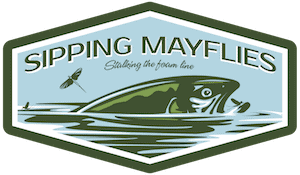Fly Fishing For Smallmouth Bass
August 15th, 2022
If you have the opportunity to go fly fishing for smallmouth bass, whether it’s in a lake or river, I highly recommend it. The simple reason is that they’re incredibly strong fighters. There’s a reason this species was Al Lindner’s favorite.
Smallmouth bass (Micropterus dolomeiu) go by many regional names, including bronzeback, smallie, bronze bass, brown bass, and bareback bass. My personal preference is “smallie.”
Fortunately, these fish generally aren’t picky eaters, and when the bite is on, you’re in for a fun day of fly fishing.
I’ve caught hundreds of smallmouths on flies, and in the below article I’m going to share with you my techniques and tactics, the most productive flies I’ve ever used, and I’ll include plenty of pictures.
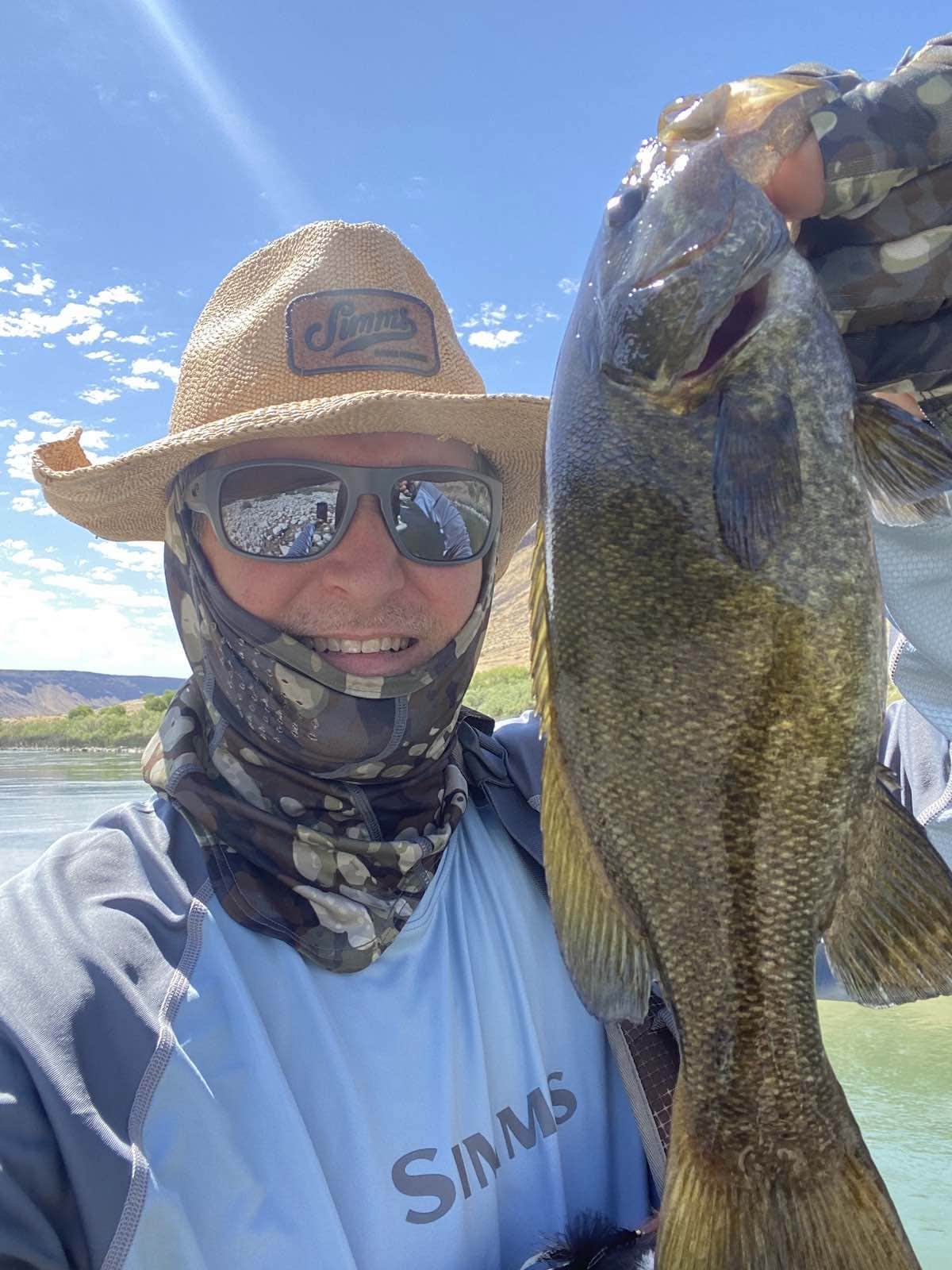
In the above picture, I’m holding a nice smallmouth I caught on the snake river using a white streamer.
The Difference Between Smallmouth and Largemouth Bass
In my experience, most anglers don’t know the difference between a smallmouth bass and a largemouth bass. Many think a smallmouth is just a young largemouth with a correspondingly smaller mouth. This isn’t correct.
Here are some of the most notable differences:
- Smallmouths have vertical stripes, while largemouths have horizontal stripes.
- Smallmouths are usually more brown or bronze than largemouths.
- Smallies are much stronger fighters than largemouths.
- Largemouths have a dorsal fin that’s split into two pieces, while a smallmouths dorsal fin is continuous.
- Largemouths prefer warm water, while smallmouths tend to prefer somewhat cooler water.
- Smallmouths don’t get nearly as big as largemouths. The world record largemouth bass was 22 pounds and 4 ounces, while the world record smallmouth bass was 11 pounds and 15 ounces.
- Largemouths have larger mouths (shocking, right?)
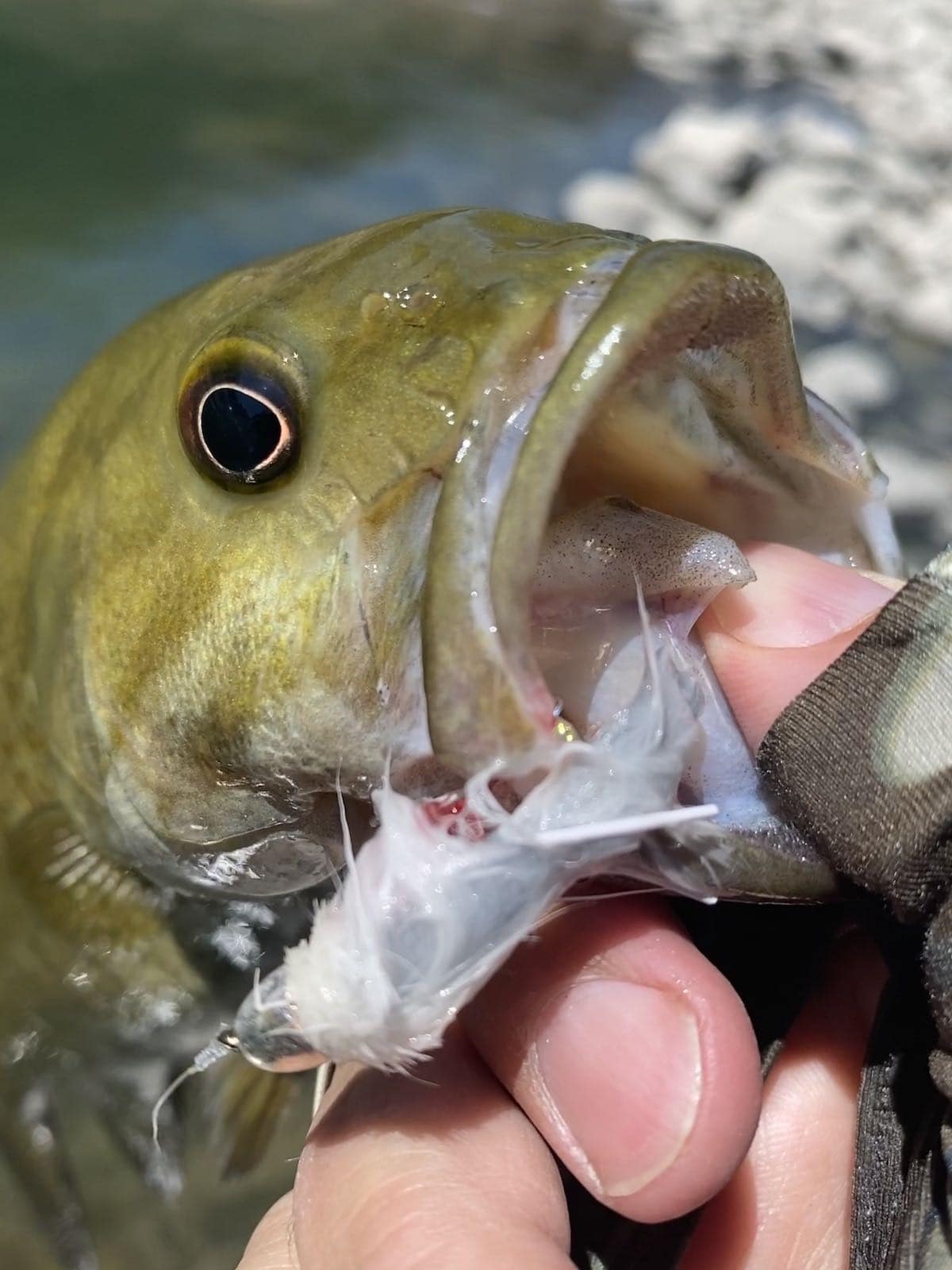
Here’s a close-up showing the inside of a smallmouth’s mouth. It’s definitely not as whale-like as a largemouth’s. You can see their small teeth as well.
Where to Find Smallmouth Bass
Smallmouth bass live in both stillwater (lakes and reservoirs) and moving water (rivers) across North America. If you have access to both types of water, it comes down to personal preference.
However, smallmouths in stillwater tend to get noticeably bigger than smallmouths that live in rivers. This is mainly because of the warmer water and less exertion against the current, which translates to more time actively feeding.
But, as is usually the case, it’s not a hard rule.
I was fly fishing the snake river a few weeks ago and hooked into a juvenile smallie using an olive woolly bugger that I was stripping along the rocky shoreline.
As I was stripping line in to land the fish, a monster smallmouth bass started trailing the smallmouth I had on the end of my fly line. It was the most massive smallie I’d ever seen. I’m not going to lie, I let it have a shot at the fish I was stripping-in, but despite it’s clear intent, it never inhaled the fish.
If I were to venture a guess, I’d say it was around seven pounds. But, it’s tough to say because it was 2-3 feet under the water’s surface. Regardless, it was a trophy.
My point is, rivers have some huge smallmouth–it’s not just lakes and reservoirs holding the big ones.
You’re going to want to focus on the shoreline shallows, which is where these fish hunt for food. Then, focus further around structure. This is where smallies hold.
Rock piles are absolute gold, but downed trees can be a jackpot too.
Avoid lily pads and soft-bottomed areas. This is where largemouths live, but not smallmouths.
Rivers that get too warm for trout can be excellent smallmouth bass fisheries.
One of my favorite spots for smallies is where water is flowing into stillwater. You can find a lot of these spots in areas like the BWCA, where streams and brooks empty into lakes. Smallmouths congregate in these spots because they act like a conveyor belt of food.
Always watch for baitfish, minnows, insects, and other prey are found along the shoreline. If you see them, so do the smallies.
You’ll generally find more smallmouths in stillwater (lakes and reservoirs) than in rivers, but not always. It really depends on your specific geographic location.
Here’s a range map of smallmouth bass distribution across the United States.
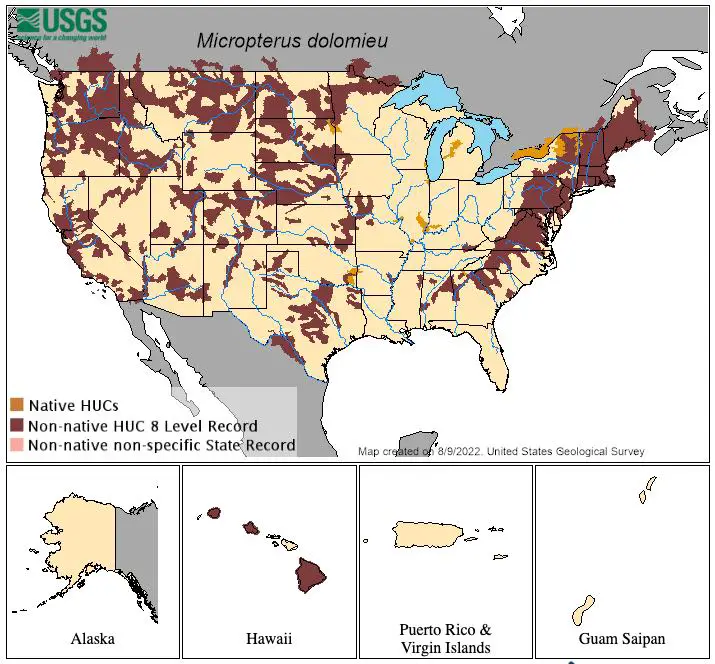
It’s virtually unheard of to find a smallie in a pond, so if you want to increase your odds, focus on lakes, reservoirs, and rivers. Largemouths, on the other hand, are almost always found in ponds.
If you’re into pond fishing, check out my article about how to fly fish in ponds.
I encourage you to check out your state’s Fish & Game website, since there’s often detailed information on what species live in each body of water.
The all tackle world record smallmouth was 11 pounds and 15 ounces, caught on the border of Tennessee and Kentucky.
Here’s a feisty smallmouth, one of 102 I caught that day. Notice the super rocky shoreline.
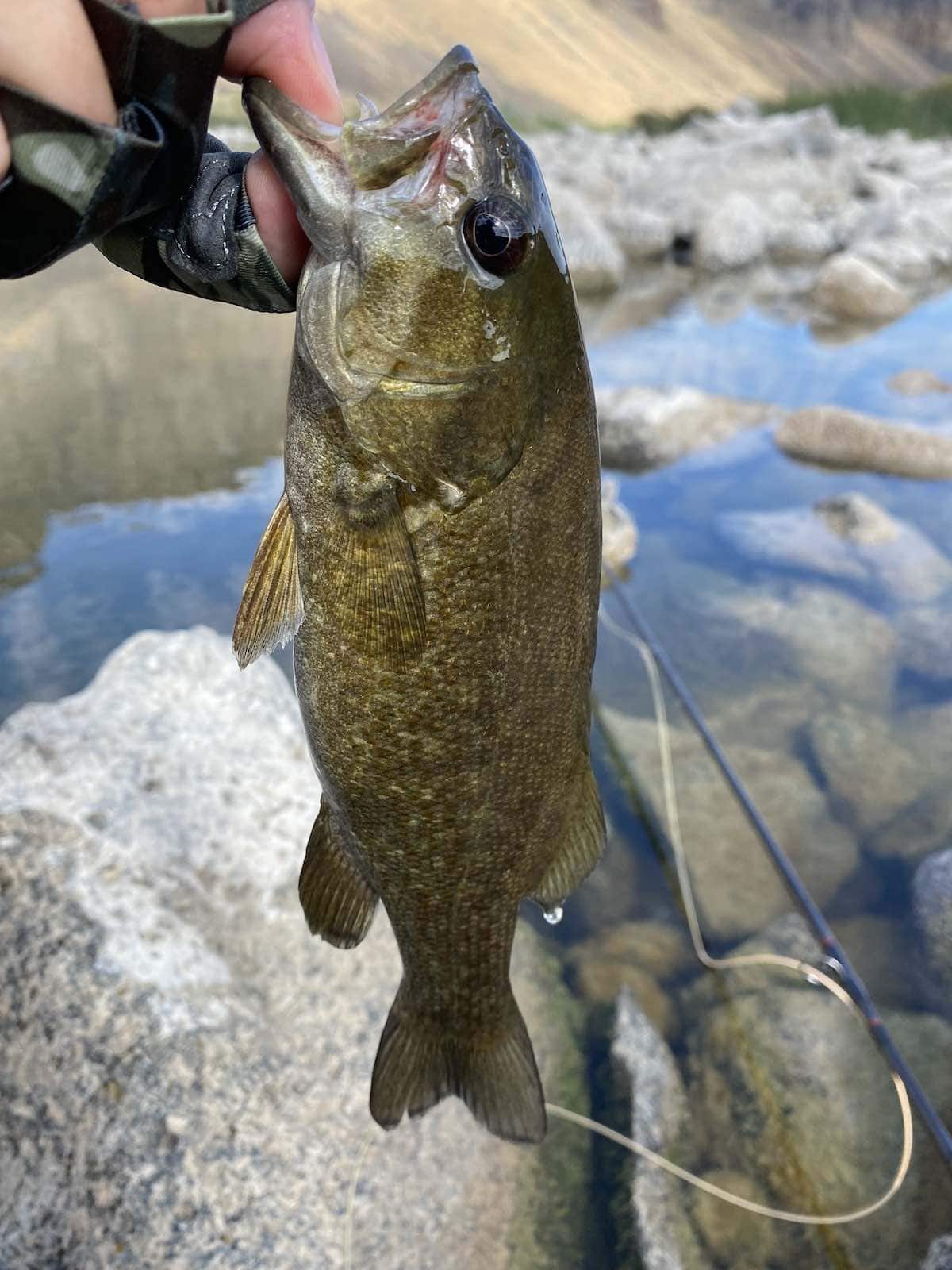
When to Fly Fish for Smallmouth Bass
Getting the timing right really comes down to water temperature. During the winter, the water temperature drops and this pushes smallmouth bass into deeper water. They become less active and their metabolism (and feeding) slows way down.
During these cold months, smallies in most areas are too deep for fly anglers, even with full sinking line and weighted fly patterns. Plus, they’re just not feeding much during this period.
Optimally, you’ll want to put your fly rod together once the water is hovering between 65F (18C) and 80F (27C). This is when smallmouths are actively hunting and eating.
In most parts of North America, this means the best time to fish for smallmouth bass is between April and October, with June, July, and August being the prime months.
But, let’s get even more granular. Let’s consider time-of-day.
The best time of day to fly fish for smallmouth bass is early morning and late afternoon. In stillwater, smallies retreat to deeper water during the hottest part of the day. However, in rivers they’re active all day.
Many anglers don’t realize that smallmouths will hit your flies throughout the night. Don’t put your gear away once the sun goes down. Surface action when it’s dark can be electrifying.
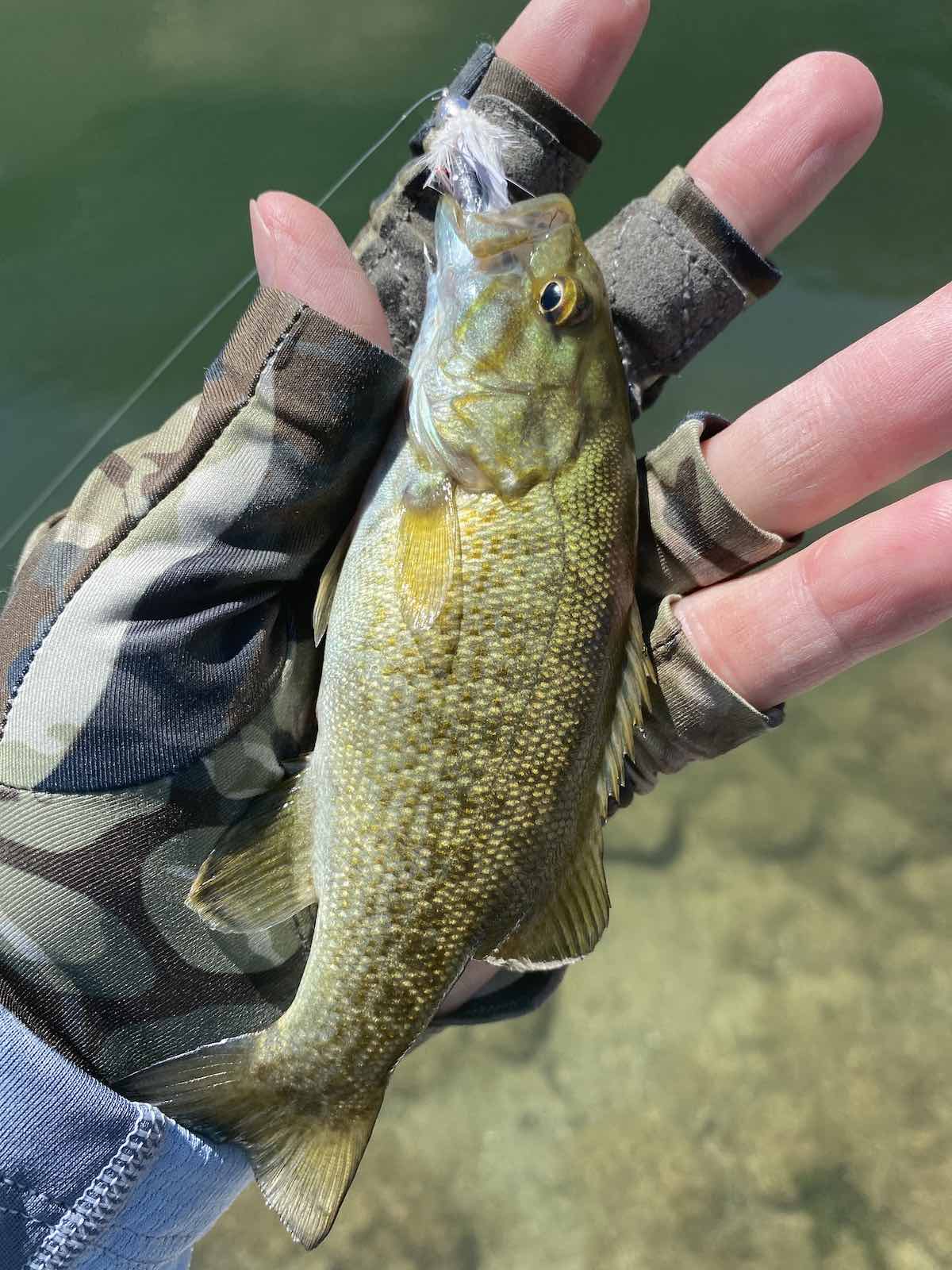
Even a juvenile smallmouth, like this one I’m holding, are aggressive feeders that’ll pull like a fish twice their size.
Smallmouth Bass Spawning Habits
Smallmouth bass spawn during springtime, not long after the ice has melted, like most North American fish species.
Once water temperatures hit around 70F (21C), the females will began laying eggs in shallow water. They can lay over 21,000 eggs each.
Male smallmouth will actually guard the eggs in the nest for up to two weeks after the fry hatch. After monitoring the fry for a couple weeks, the males join the females in deeper water where they feed and recuperate.
It’s worth mentioning that I implore you to avoid casting to spawning or nesting smallmouths. It’s not worth the potential long-term damage. Believe it or not, many fish that are released end up perishing regardless due to a litany of factors including oxygen depletion, stress, infection, and more.
What do Smallmouth Bass Eat?
Smallmouth bass are strict carnivores that eat a variety of live foods including minnows, sculpins, dace, frogs, salamanders, leeches, sunfish, as well as aquatic and terrestrial insects. Their favorite food, however, is undoubtedly crayfish.
If you can locate crayfish in a body of water, that’s the spot where the smallmouth will congregate.
The Best Smallmouth Bass Flies
Below I’ll detail the most productive fly patterns I’ve personally used to catch plenty of smallmouth bass. With that said, there are many other flies that’ll work well too. As I’ve mentioned, smallmouth aren’t overly picky fish.
In the subsequent section, I’ll explain exactly how I fish each of them to catch the most fish.
Streamers
Tossing streamers is probably the most popular method fly anglers use to catch smallmouth. It’s certainly my go-to method. These subsurface flies come in a variety of shapes, weights, and sizes.
Clouser Minnow
These streamers are synonymous with catching many different freshwater and saltwater species subsurface. It’s a classic for a reason.
It’ll sink quickly, which actually makes it more maneuverable in the water–it gives you more control.
You can get these in a huge variety of colors and weights, but I recommend a size 2-8 for most situations.
My favorite colors are white, chartreuse, and white with some red streaking. You can get the exact pattern I use on this page at Amazon.
Woolly Bugger
Speaking of classics, there’s also a reason this pattern is a must for any fly angler worth his or her salt. If you don’t have these in your fly box, get some.
They can mimic leeches, crayfish, minnows, and just about any other prey item.
Similar to the clouser, these come in many versions, including non-weighted, beadhead, and conehead. Name your color, and it’s available.
The best colors in my personal experience are orange (think crayfish and bounce it off the bottom), black, and white.
Size-wise, I recommend sizes 4-10. Generally speaking, the larger the fly, the larger the fish. But again, not always.
You can get the exact pattern I’m referencing on this page at Amazon.
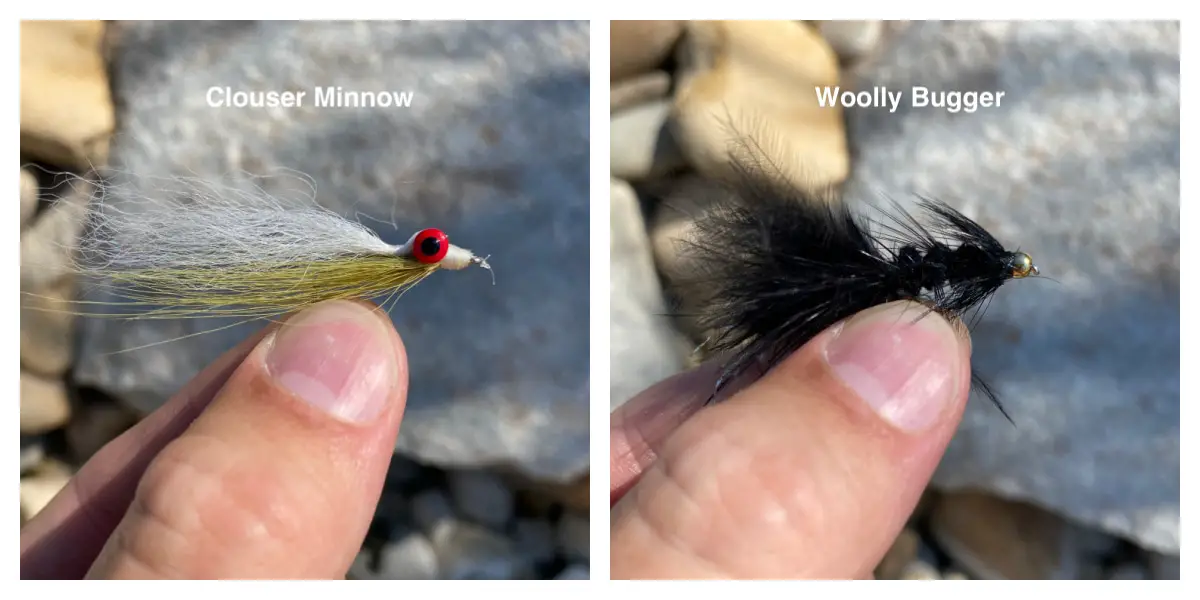
Dry Flies
While not the most productive method from a numbers standpoint, this is definitely my favorite way to catch smallmouth bass. There’s an excitement embedded in the connection you have with a fish taking your fly at the surface.
Late spring through summer is the best time of year for dry flies if you’re targeting smallies.
Damselfly pattern
If you see damselflies or dragonflies buzzing around (this would be during summer), tie-on a corresponding pattern and buckle-up, because smallmouth relish these bugs.
There are times when you’ll catch a smallmouth on every cast, or close to it.
Remember, the giant ones are dragonflies, and the little blue ones are damselflies.
Cast these so they plop down hard on the surface. Then let them be still for 10-30 seconds. If there’s no action, give it a quick, short tug. And repeat.
Here’s an article I wrote focused entirely on fly fishing with dragonfly (and damselfly) patterns.
Popper
Poppers can imitate just about any edible prey animal that could be found on the surface, including frogs, mice, large insects, and more.
Smallmouths aren’t going to hyper-analyze your popper. You just want it to float and move some water as you strip it in.
Color-wise, green, brown, and yellow tend to be the most productive for me.
I recommend you use sizes 2-6. Poppers that include rubber legs are preferred. You can find some effective ones on this page at Amazon.
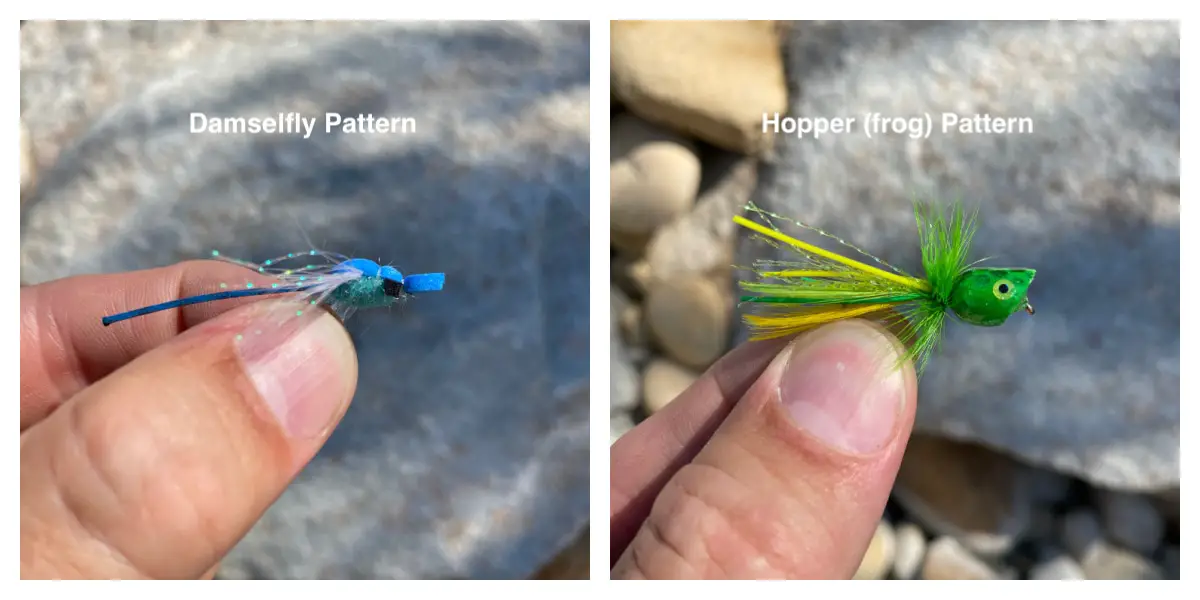
Nymphs
Nymphs aren’t what most people think of when they consider angling for smallmouth. But, they can be very productive.
In fact, I know of several fly anglers who’ve caught trophy smallmouths on tiny size 20 zebra midge nymph patterns drifting under an indicator.
Now, I don’t fly fish for smallmouth bass using an indicator, it’s just not my style, but I do cast and retrieve certain nymph patterns.
(Beadhead) Soft Hackle Pattern
Ok, this is technically a wet fly, but it can be deadly against smallmouth. In fact, this is the fly pattern I caught 102 smallies on in one day. Specifically, a size 16.
I think the fish like that the soft hackle pulses and gives life to the fly. Soft hackle, by the way, is the protruding soft feathers surrounding the head of the fly.
(Beadhead) Pheasant tail Nymph
Pheasant tail nymphs are a must-have pattern in any fly angler’s box. They’re indispensible and super productive.
I prefer the beadhead version since it sinks well, but it also makes the fly easier for the fish to throw during an aerial jump.
You’re going to, on average, catch smaller bass with nymphs (there are always exceptions, per above). But, on the flip side of the coin, you’re also more likely to catch a lot of smallmouths.
You can pick up some on this page at Amazon.
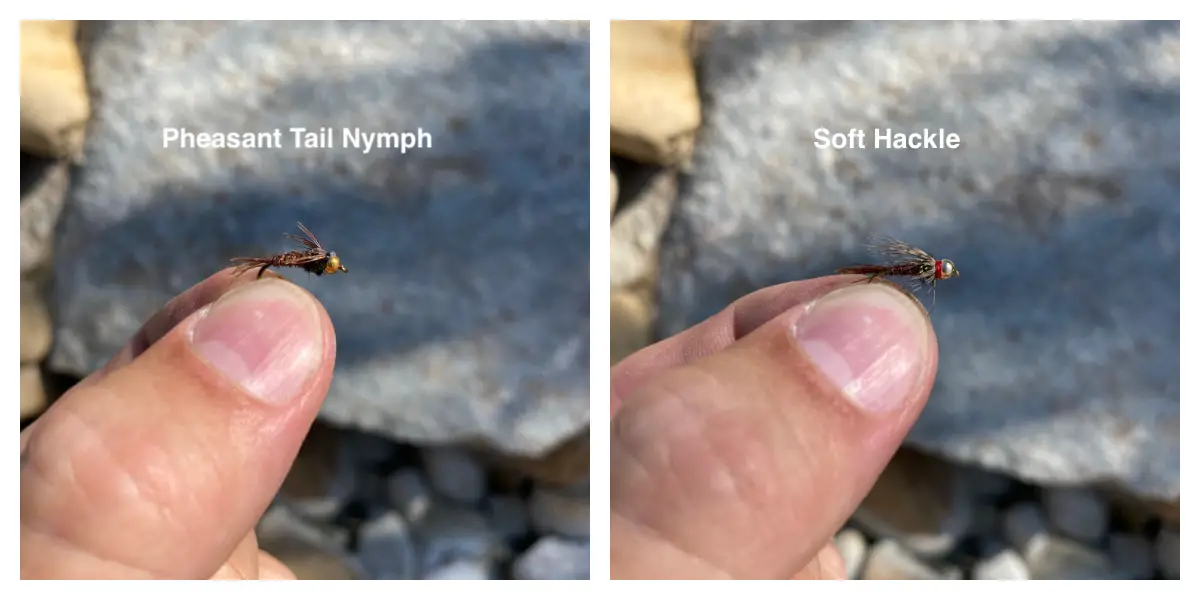
Techniques for Catching Smallmouth Bass
Stillwater
Stillwater includes both lakes and reservoirs.
If you’ve got access to a boat, I’d highly recommend it. This allows you to comfortably and cast towards the shoreline, where the smallmouths are hunting. Focus on structure, whether that be rocks, sunken logs, or submerged trees.
When you don’t have a boat, you can still catch plenty of fish standing on the shore. In this case, use the same strategy of finding structure.
I almost always start with a popper fly, and let it hit the water’s surface hard. I let it sit for 30 seconds or so, then give it a little action. Vary your retrieve until you find what they’re keying in on.
If you remember nothing else, please remember that when chasing smallmouths, you want to let your dry flies sit motionless on the surface for what seems like an excruciatingly long period of time.
If dries aren’t working as well as I’d like, I switch over to a streamer like a clouser.
Again, cast over and alongside structure, varying your retrieve.
I usually begin with short 6-10 inch strips, and try to refine things until I find what the fish want. One thing that I’ve discovered is that smallmouth bass very often like to hit my fly in-between strips, when the fly is falling. I’m guessing the fish think their prey is exhausted and is an easy meal.
Some fly anglers say never to allow slack in your line because you’ll miss takes, but I find that with smallmouths you definietly want to allow your streamer or nymph to drop through the water column, often for a few seconds.
Rivers
My favorite place for smallmouths is on a rocky and boulder strewn river shoreline. The more rocks the better. Rocks are like magnets for smallies.
If you’re on a river using dry flies, it should go without saying that you want a drag-free drift. Same rules apply about letting your fly make a lot of commotion when it hits the water’s surface.
Often times smallmouths will hit my dry fly within a second or two of it hitting the water. You’ll see this time and time again.
If I’m using streamers or nymphs, I generally cast downsteam parallel to the shoreline and start stripping line back. I tend to avoid casting in water where I can’t see the bottom.
The beautiful thing about this method is that you can often watch the smallmouth approach and take your fly. This is how I’ve learned so much about them, especially that they like taking a fly as it drops (in-between strips).
I’ve been fortunate enough to watch takes like this hundreds of times.
If the water’s a bit dirty, you can watch the tip of your fly line instead. When the fly is dropping, and you see your line jolt a few inches, set the hook.
Sometimes I cast my streamers or nymphs upstream too, and this works relatively well, but usually not as well as casting downstream.
Super slow retrieves can work, but I generally stick with a faster retrieve.
PRO TIP: Sometimes a dead drift works exceptionally well with smallmouth bass. Specifically, cast towards areas with overhanging trees and let your fly sit for 5-6 seconds. Just let it drift. Don’t move it. This can work exceptionally well, since smallies think it’s an insect that fell from the tree branches.
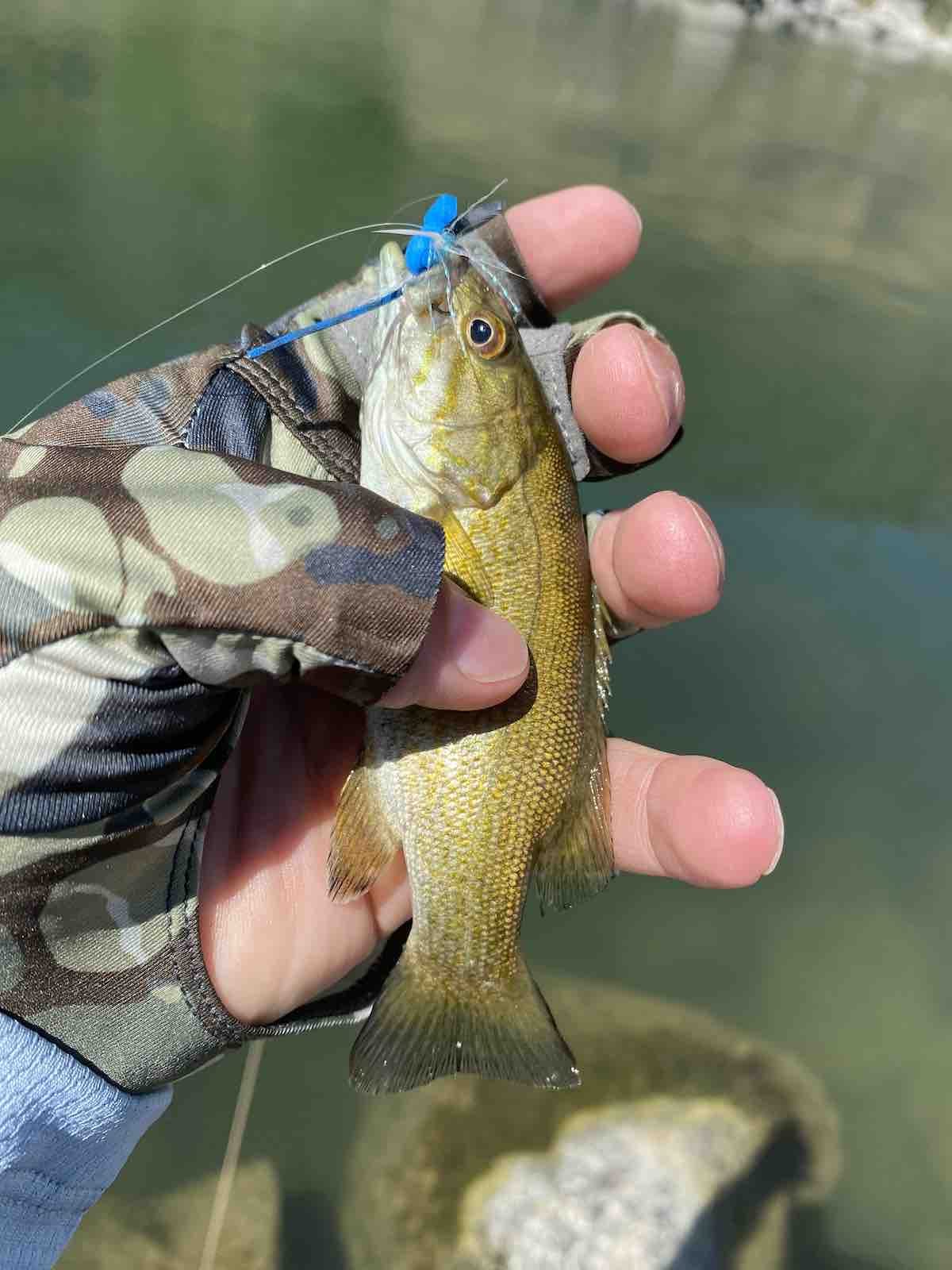
This tiny smallmouth bass took my damselfly pattern.
General Tactics
Expect a smallmouth bass to go airborne during the fight. It happens more often then not.
When the fish is in the air, give it a little slack line. Some call this, “Bowing to the fish.”
It’s a tactic that helps reduce the chance the fish will throw your fly. This is especially likely with weighted (ie. beadhead, etc) fly patterns.
As I mentioned, smallies aren’t the most discriminating feeders. If they’re eating big mayflies off the surface, they’ll probably take your popper too.
Also, don’t cast to the same area for too long. The fish will get used to your fly and will start to ignore it.
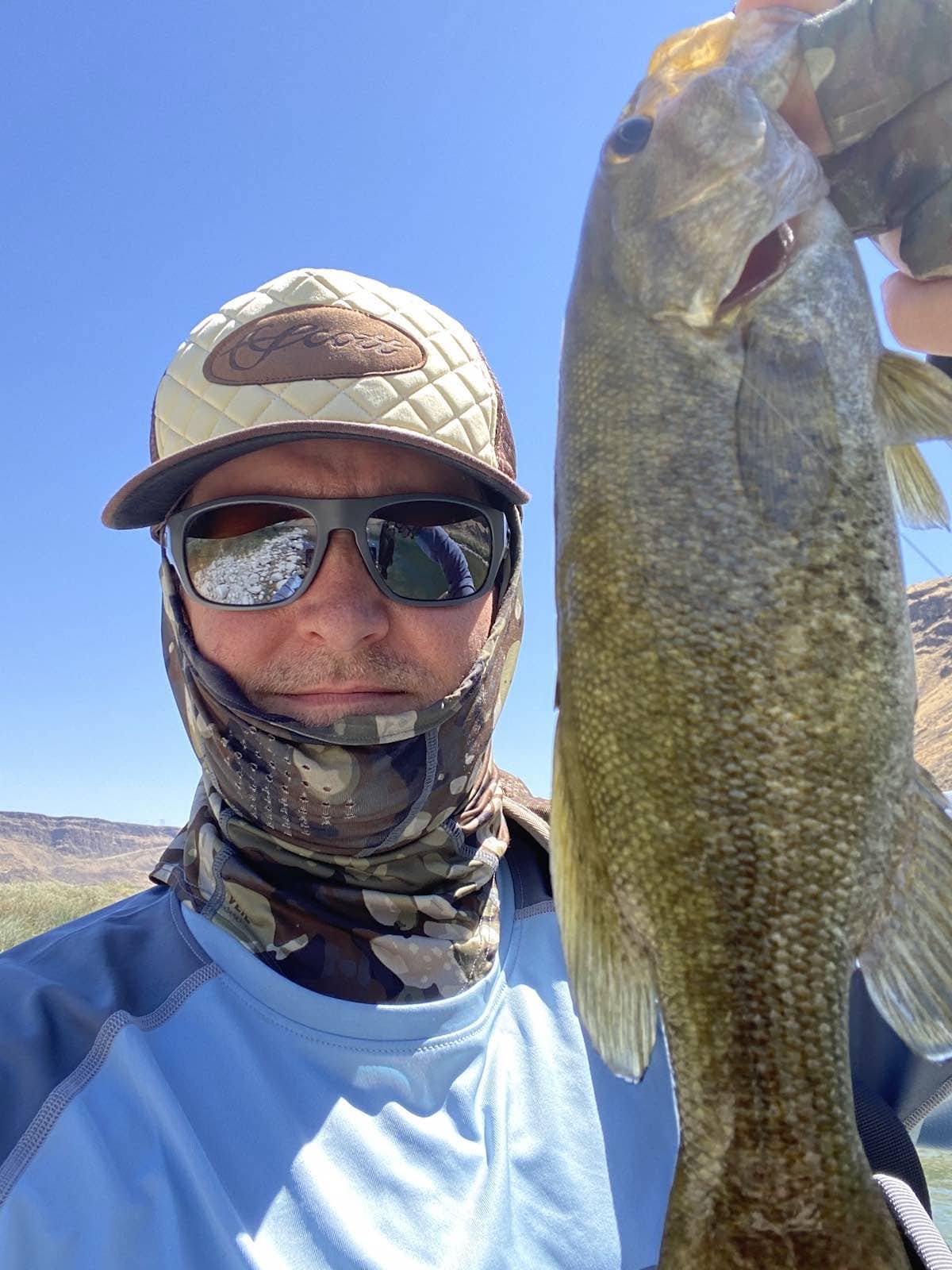
Recommended Fly Gear
Fly Rods
You’re going to want a 6-7 weight fly rod for smallmouth bass. Personally, I like to use a 7-weight.
Can you get by with a 5-weight? Perhaps. But I don’t recommend it.
The reason you want a heavier rod is twofold.
Firstly, you’ll be able to wrestle with big fish. Trying to pull a monster smallmouth bass from the rocks with a 5-weight sounds close to hopeless.
Secondly, you’re going to be casting big popper and streamers. This is much easier with a stronger rod, especially if you’re dealing with any wind.
Length-wise, I’d recommend either an 8.5-foot or 9-foot rod.
Fly Reels
Fly reels tend to be a bit of an afterthought. The reason is, you don’t put most fish on the reel. This means you strip them in, rather than reel them in.
Smallmouths, though, pull hard. Just make sure to get something relatively well made. This reel from Redington will do the job just fine.
Fly Line
If you’re going to be focusing on dry flies, get a weight-forward floating line.
If you’re planning on using streamers often, I’d recommend getting this sink tip line, or this full sinking line.
The full sinking line will begin sinking the moment it hits the water. The sink rate is measured in IPS (Inches Per Second).
A sink tip line is a standard weight-forward floating line, but the last 10-20 feet of line will sink. So, the tip of the line sinks, thus the name.
Leader & Tippet
Smallmouth bass aren’t as leader shy as trout, so you can get away with thicker line. This is of course convenient since they’re such strong fish.
I’d personally recommend that you get a 1X to 3X leader and tippet, and preferably fluorocarbon instead of monofilament. Fluorocarbon is noticeably stronger than monofilament, and it’ll sink faster too.
If you’re casting dry flies, I recommend a 9-12 foot leader.
When it comes to streamers, you don’t need as long of a leader. A length of 5-6 feet is just fine.
General Gear
Make sure you’ve got a good pair of forceps or hemostats. I wrote an article explaining the best forceps and how to use them.
This is important because smallmouth bass will inhale your fly, and you need to be able to remove it quickly and as gently as possible.
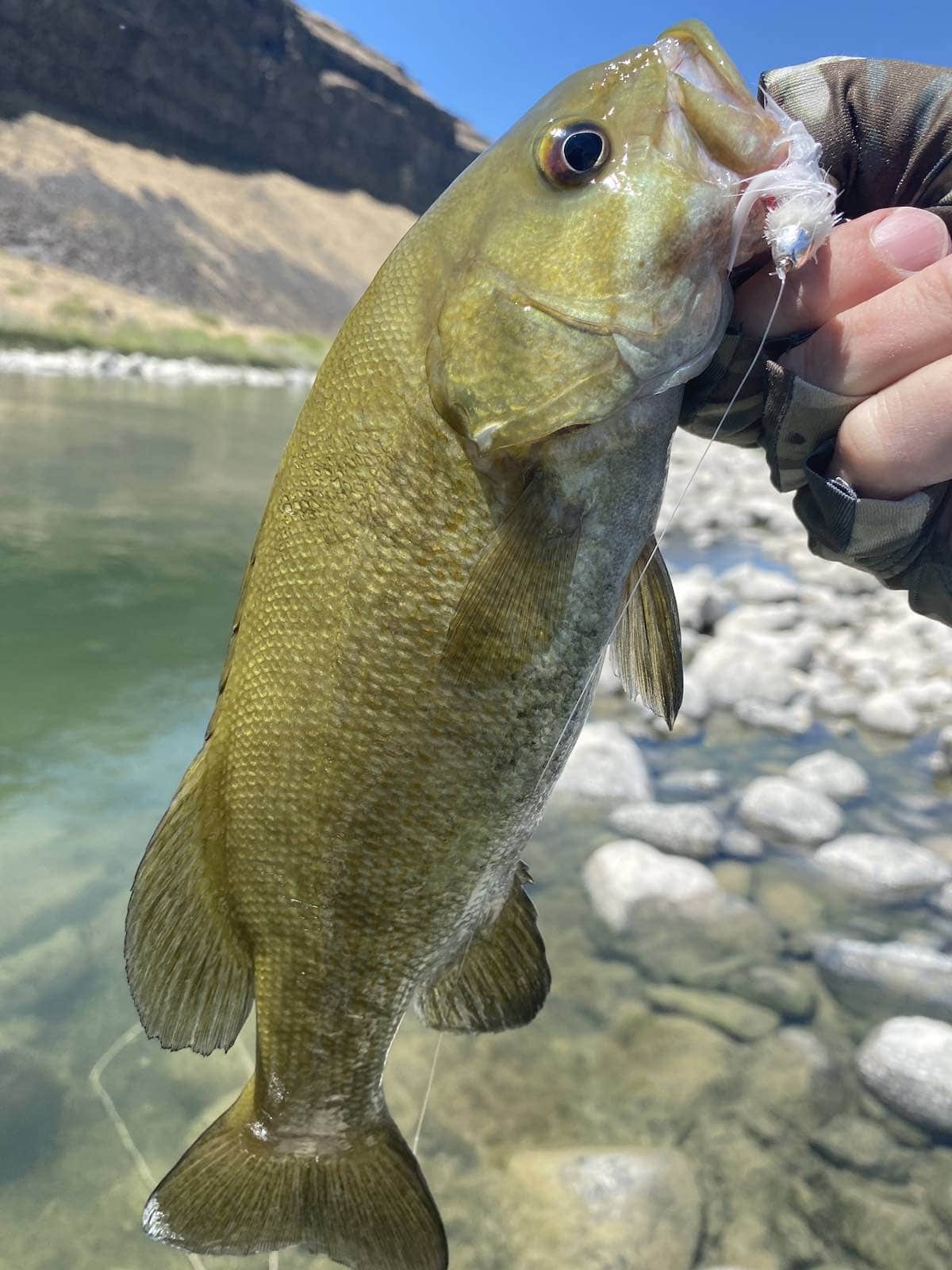
Summary
Smallmouth bass are hugely popular in fly fishing circles, and for good reason. They’re aggressive feeders and pound-for-pound some of the strongest fighters in the world.
These acrobatic fish are very willing to take your fly, and will provide hours of action on the water. If you’ve never chased them, I highly recommend you give them a try.
If you found my article helpful, e-mail me a picture of one of the smallmouths you end up catching!
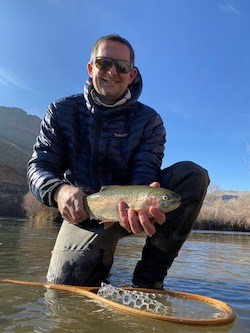
About the Author
My name's Sam and I'm a fly fishing enthusiast just like you. I get out onto the water 80+ times each year, whether it's blazing hot or snow is falling. I enjoy chasing everything from brown trout to snook, and exploring new waters is something I savor. My goal is to discover something new each time I hit the water. Along those lines, I record everything I learn in my fly fishing journal so I can share it with you.
Follow me on Instagram , YouTube, and Facebook to see pictures and videos of my catches and other fishing adventures!
